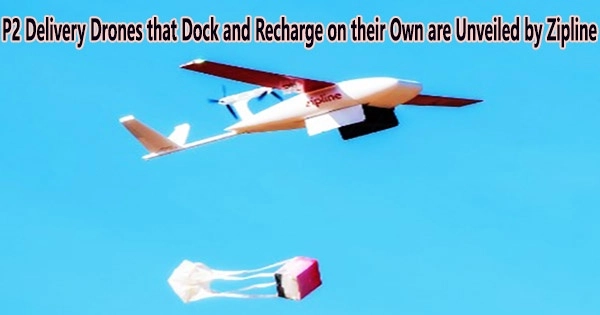Since its establishment in 2014, the logistics start-up Zipline has flown more than 38 million kilometers with its autonomous electric delivery drones. In Rwanda, Zipline put its first fleet to work supplying clinics and hospitals with blood and other medical supplies. With limited delivery service and distribution locations in three states, the Silicon Valley business has since expanded its service to six additional nations.
On Wednesday (March 15, 2023), Zipline showed off its next-generation aircraft, which it hopes will make rapid aerial deliveries an everyday convenience for customers throughout the U.S., even in densely populated urban areas.
Zipline’s new drone, dubbed the Platform 2 or P2 Zip, is capable of carrying up to eight pounds worth of cargo within a ten-mile radius, and can land a package on a space as small as a table or doorstep.
“The reason that number is important,” says Zipline CEO and co-founder Keller Rinaudo Cliffton, “is that when you look at e-commerce in the US, a vast majority of packages weigh five pounds or less.”
“The P2 Zip can travel ten miles in ten minutes, and the company can make a delivery approximately seven times faster than any typical service you may order from today,” the CEO said. Rapid deliveries by drone may put an end to “porch pirates,” Rinaudo Cliffton said, referring to the theft of packages left on a doorstep while the customer is away from home.
While the P1 Zip, Zipline’s first drone, has a fixed wing or glider-like construction, the P2 has both lift and cruise propellers in addition to a fixed wing. These help it maneuver precisely and quietly, even in rainy or windy weather.
To deliver cargo to a customer’s door, the P2 Zip hovers around 300 feet above ground level and dispatches a kind of mini-aircraft and container called the “droid.” The droid lowers on a long thin line, and moves softly into place with fan-like thrusters before setting down for package collection.
People are worried about noise, rightly. I’m worried about noise. I don’t want to live in a world where there’s a bunch of loud aircraft flying above my house. Success for us looks like being in the background, being barely audible.
Jo Mardall (Zipline head of engineering)
Zipline’s original P1 drones will remain in production and in wide use, says Rinaudo Cliffton. The P1 Zip can fly a longer distance, delivering up to five pounds of cargo within a 60-mile radius, but it requires a larger space for take off, landings and “the drop.”
The P1 Zip releases cargo while still tethered to a parachute, and its payload drops in an area roughly the size of two parking spaces. A P1 Zip must be disassembled after it returns to base, then a new one must be set up with a newly charged battery for the subsequent flight.
Zipline’s new P2 Zip can dock and power up autonomously at a charging station that looks something like a street lamp with an arm and a large disc attached to that arm:
Depending on the regulations and permits, zipline docks can be put in a single parking space or next to a structure. Zipline imagines the droid being pushed into a window or dumbwaiter, retrieved, and reloaded within by medical personnel using docks set up by eateries in a downtown retail district or beside the exterior wall of a hospital.
Setting up one of these docks takes about as much work as installing an electric vehicle charger, Rinaudo Cliffton said.
Before developing the P2 Zip, Zipline had established logistics networks in Cote d’Ivoire, Ghana, Japan, Kenya, Nigeria and Rwanda already. It is operating some drone delivery networks in the US, in North Carolina, Arkansas and Utah but the P2 will help it expand that network.
Partners who plan to test deliveries via P2 Zip include the healthy fast-casual restaurant Sweetgreen, Intermountain Health in Salt Lake City, Michigan Medicine, Multicare Healthcare System in Tacoma, Wash., and the government of Rwanda.
Zipline is not alone in its ambitions. Zipline is part of a program with other startups like DroneUp and Flytrex to make deliveries for Walmart. Amazon, meanwhile, has been working on making drone deliveries a reality here for nearly a decade, although that business has struggled to overcome a thicket of regulation and low demand from test customers.
Quiet and green is the goal
Zipline head of engineering Jo Mardall told CNBC the company focused much of its engineering on making sure the drones were not just safe and energy-efficient, but also quiet enough that residents would embrace their use.
“People are worried about noise, rightly. I’m worried about noise. I don’t want to live in a world where there’s a bunch of loud aircraft flying above my house,” he said. “Success for us looks like being in the background, being barely audible.” That means something closer to rustling leaves than a car driving by.
The P2 Zips have a unique propeller design that makes this possible, Mardall explained, adding, “The fact that the Zip delivers from from 300 feet up really helps a lot.”
Mardall and Rinaudo Cliffton emphasized that Zipline aims to have a net-beneficial impact on the environment while giving business a better way to move everything from hot meals to refrigerated vaccines just in time to customers.
Unmanned aerial vehicles, they explained, avoid worsening traffic congestion by going overhead. And since Zipline’s drones are electric, they can be powered with renewable or clean energy, without the emissions from burning jet fuel, gasoline, or diesel.
But most importantly, the CEO said, Zipline’s drone delivery allows companies to “centralize more inventory,” and “dramatically reduce waste.”
A study published by Lancet found that hospitals using Zipline services were able to reduce their total annual blood supply waste rate by 67%, the CEO boasted.
“That is a mind-blowing statistic, and a really big deal. It saves health systems millions of dollars, by reducing inventory at the last mile and only sending it when it’s needed.”
Zipline is aiming to bring that efficiency to every corner of commerce, the CEO said. It’s also aiming to keep the cost of drone delivery competitive with existing services, like FedEx and UPS, or food delivery apps like Uber Eats and Instacart.
But first, the startup plans to conduct more than 10,000 test flights using about 100 new P2 Zips this year. With its existing P1 drones, Zipline is already on track to complete about 1 million deliveries by the end of 2023, and by 2025 it expects to operate more flights annually than most commercial airlines.
















